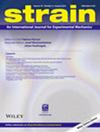Combined thermographic phosphor and digital image correlation (TP + DIC) for simultaneous temperature and strain measurements
IF 1.8
3区 材料科学
Q2 MATERIALS SCIENCE, CHARACTERIZATION & TESTING
引用次数: 3
Abstract
Thermographic phosphors (TP) are combined with stereo digital image correlation (DIC) in a novel diagnostic, TP + DIC, to measure full‐field surface strains and temperatures simultaneously. The TP + DIC method is presented, including corrections for nonlinear CMOS camera detectors and generation of pixel‐wise calibration curves to relate the known temperature to the ratio of pixel intensities between two distinct wavelength bands. Additionally, DIC is employed not only for strain measurements but also for accurate image registration between the two cameras for the two‐colour ratio method approach of phosphoric thermography. TP + DIC is applied to characterize the thermo‐mechanical response of 304L stainless steel dog bones during tensile testing at different strain rates. The dog bones are patterned for DIC with Mg3F2GeO4:Mn (MFG) via aerosol deposition through a shadow mask. Temperatures up to 425°K (150°C) and strains up to 1.0 mm/mm are measured in the localized necking region, with conservative noise levels of 10°K and 0.01 mm/mm or less. Finally, TP + DIC is compared to the more established method of combining infrared (IR) thermography with DIC (IR + DIC), with results agreeing favourably. Three topics of continued research are identified, including cracking of the aerosol‐deposited phosphor DIC features, incomplete illumination for pixels on the border of the phosphor features, and phosphor emission evolution as a function of applied substrate strain. This work demonstrates the combination of phosphor thermography and DIC and lays the foundation for further development of TP + DIC for testing in combined thermo‐mechancial environments.用于同时测量温度和应变的热成像磷光体和数字图像相关(TP+DIC)组合
热成像磷光体(TP)与立体数字图像相关(DIC)结合在一种新的诊断方法TP+DIC中,以同时测量全场表面应变和温度。提出了TP+DIC方法,包括对非线性CMOS相机检测器的校正,以及生成像素校准曲线,以将已知温度与两个不同波段之间的像素强度比联系起来。此外,DIC不仅用于应变测量,还用于磷酸热成像的双色比方法的两台相机之间的精确图像配准。TP+DIC用于表征304L不锈钢狗骨在不同应变速率下拉伸试验过程中的热机械响应。通过荫罩的气溶胶沉积,用Mg3F2GeO4:Mn(MFG)对狗骨头进行DIC图案化。温度高达425°K(150°C),应变高达1.0 mm/mm是在局部颈缩区域测量的,保守噪声水平为10°K和0.01 mm/mm或更小。最后,将TP+DIC与更成熟的将红外(IR)热成像与DIC(IR+DIC)相结合的方法进行了比较,结果一致。确定了三个持续研究的主题,包括气溶胶沉积的磷光体DIC特征的破裂、磷光体特征边界上像素的不完全照明,以及作为施加的衬底应变的函数的磷光体发射演化。这项工作展示了磷光体热成像和DIC的结合,并为进一步开发TP+DIC在热-机械复合环境中的测试奠定了基础。
本文章由计算机程序翻译,如有差异,请以英文原文为准。
求助全文
约1分钟内获得全文
求助全文
来源期刊

Strain
工程技术-材料科学:表征与测试
CiteScore
4.10
自引率
4.80%
发文量
27
期刊介绍:
Strain is an international journal that contains contributions from leading-edge research on the measurement of the mechanical behaviour of structures and systems. Strain only accepts contributions with sufficient novelty in the design, implementation, and/or validation of experimental methodologies to characterize materials, structures, and systems; i.e. contributions that are limited to the application of established methodologies are outside of the scope of the journal. The journal includes papers from all engineering disciplines that deal with material behaviour and degradation under load, structural design and measurement techniques. Although the thrust of the journal is experimental, numerical simulations and validation are included in the coverage.
Strain welcomes papers that deal with novel work in the following areas:
experimental techniques
non-destructive evaluation techniques
numerical analysis, simulation and validation
residual stress measurement techniques
design of composite structures and components
impact behaviour of materials and structures
signal and image processing
transducer and sensor design
structural health monitoring
biomechanics
extreme environment
micro- and nano-scale testing method.
 求助内容:
求助内容: 应助结果提醒方式:
应助结果提醒方式:


